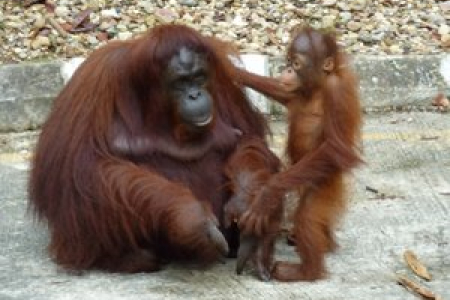Tourists may offer last hope for endangered orang-utans
Tourists visiting Borneo are willing to pay to conserve the last remaining wild populations of endangered orang-utans, with the conservation of the species valued at millions of dollars to the local tourist industry each year.
A team of researchers has been investigating the attitudes of visitors to orang-utan related tourist attractions such as reserves and rehabilitation centres in the Malaysian state of Sarawak on the island of Borneo.
Charles Darwin University Northern Institute’s Senior Research Fellow Dr Kerstin Zander and Research Institute for the Environment and Livelihoods Professor Stephen Garnett contributed to the research paper published in "Conservation and Society".
Dr Zander, who was lead author of the paper, said that the orang-utan population on Borneo had declined by more than 50 per cent during the past 60 years, with fewer than 2000 wild orang-utans remaining in Sarawak.
“With nearly all truly wild orang-utans confined to a remote site on the Indonesian border, it makes them difficult for tourists to see in the wild,” Dr Zander said. “Yet, each year thousands of tourists and local Sarawak locals see orang-utans semi-wild in a reserve or captive in a rehabilitation centre.”
With no economic value attached to the orang-utans, the research team conducted a series of surveys and interviews with visitors at the Semenggoh Nature Reserve in Sarawak to assess the value of wild and captive orang-utan populations to the local economy.
“We found that 60 per cent of respondents were willing to pay to ensure survival of a wild orang-utan population,” Dr Zander said. “International tourists tended to regard wild survival as being more important than having a high probability of seeing orang-utans personally. Indeed they preferred wild orang-utans to be hard to find.”
Professor Garnett said the researchers estimated that about USD $6.6 million a year could be made available to wild orang-utan conservation from voluntary contributions by visitors to the semi-wild animals.
“We also estimated that the 40 per cent of visitors to these facilities who come to Sarawak primarily because of the apes, bring between USD $13 million and USD $23 million into the local economy each year,” Professor Garnett said.
“Our results also suggest that far fewer would come if there were no wild orang-utans in Sarawak. It is the wild orang-utans that deliver the value to tourists even though it is the captive ones that they experience, with both being necessary for the animals to deliver a benefit to the Sarawak economy. It seems orang-utans must simply persist in the wild, for visitors to gain the pleasure from knowing that they do so.”
The research was a collaborative project between CDU and the Institute for Biodiversity and Environmental Conservation, Universiti Malaysia Sarawak, Kota Samarahan, Sarawak, Malaysia.
To view the paper visit W: www.conservationandsociety.org/article.asp?issn=0972-4923;year=2014;volume=12;issue=1;spage=27;epage=42;aulast=Zander;type=0
